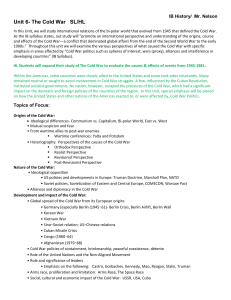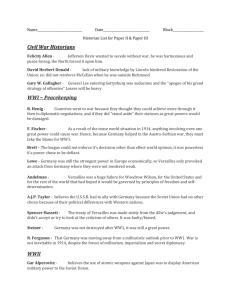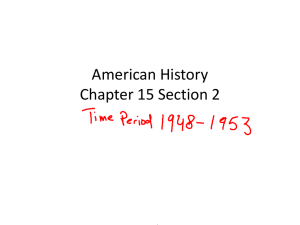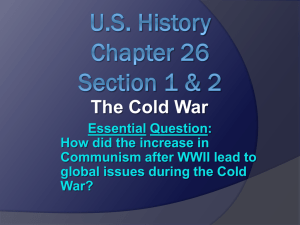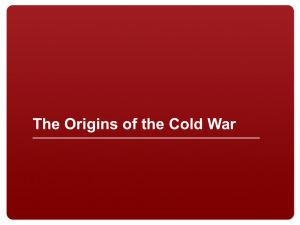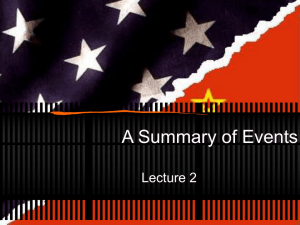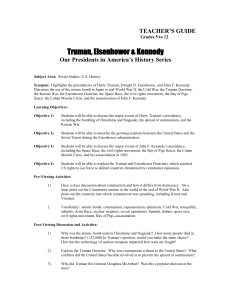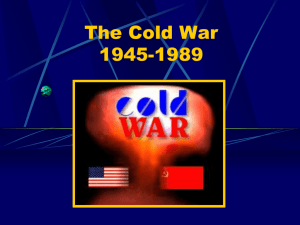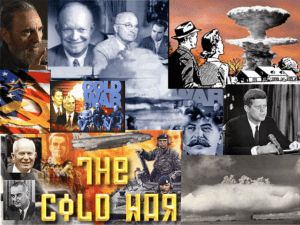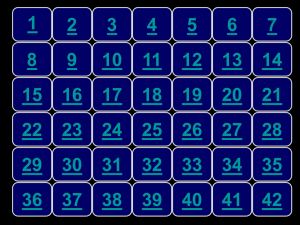US History Unit 7: Post WWII to 1960
advertisement
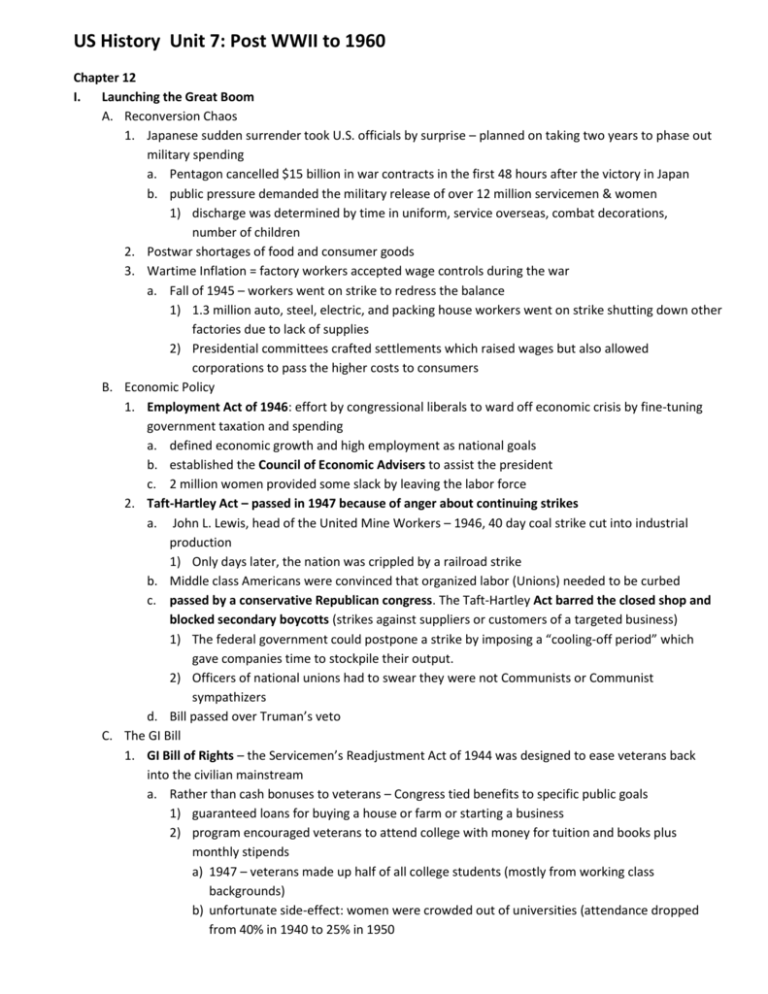
US History Unit 7: Post WWII to 1960 Chapter 12 I. Launching the Great Boom A. Reconversion Chaos 1. Japanese sudden surrender took U.S. officials by surprise – planned on taking two years to phase out military spending a. Pentagon cancelled $15 billion in war contracts in the first 48 hours after the victory in Japan b. public pressure demanded the military release of over 12 million servicemen & women 1) discharge was determined by time in uniform, service overseas, combat decorations, number of children 2. Postwar shortages of food and consumer goods 3. Wartime Inflation = factory workers accepted wage controls during the war a. Fall of 1945 – workers went on strike to redress the balance 1) 1.3 million auto, steel, electric, and packing house workers went on strike shutting down other factories due to lack of supplies 2) Presidential committees crafted settlements which raised wages but also allowed corporations to pass the higher costs to consumers B. Economic Policy 1. Employment Act of 1946: effort by congressional liberals to ward off economic crisis by fine-tuning government taxation and spending a. defined economic growth and high employment as national goals b. established the Council of Economic Advisers to assist the president c. 2 million women provided some slack by leaving the labor force 2. Taft-Hartley Act – passed in 1947 because of anger about continuing strikes a. John L. Lewis, head of the United Mine Workers – 1946, 40 day coal strike cut into industrial production 1) Only days later, the nation was crippled by a railroad strike b. Middle class Americans were convinced that organized labor (Unions) needed to be curbed c. passed by a conservative Republican congress. The Taft-Hartley Act barred the closed shop and blocked secondary boycotts (strikes against suppliers or customers of a targeted business) 1) The federal government could postpone a strike by imposing a “cooling-off period” which gave companies time to stockpile their output. 2) Officers of national unions had to swear they were not Communists or Communist sympathizers d. Bill passed over Truman’s veto C. The GI Bill 1. GI Bill of Rights – the Servicemen’s Readjustment Act of 1944 was designed to ease veterans back into the civilian mainstream a. Rather than cash bonuses to veterans – Congress tied benefits to specific public goals 1) guaranteed loans for buying a house or farm or starting a business 2) program encouraged veterans to attend college with money for tuition and books plus monthly stipends a) 1947 – veterans made up half of all college students (mostly from working class backgrounds) b) unfortunate side-effect: women were crowded out of universities (attendance dropped from 40% in 1940 to 25% in 1950 D. Assembly-Line Neighborhoods 1. Postwar housing shortage 2. VA mortgage program: allowed veterans to get home purchase loans from private lenders without a down payment a. Levittown Houses: small, affordable homes built with assembly line, pre-fabrication methods II. Truman & the Election of 1948 A. “Vital Center” – book that linked anti- Communism in foreign policy with efforts to enact social and economic policies 1. Democratic Party (1948-1968) - commitment to New Deal Reforms, extended freedom abroad, party popularity with labor B. Truman: bipartisan coalition (Republicans & Democrats) C. Election of 1948 1. Progressive Party candidate Henry Wallace a. denounced American foreign policy claiming that it diverted attention from issues of racism and poverty in America 2. States’ Rights Party candidate Strom Thurmond a. Dixiecrats- opposed civil rights for African Americans 3. Republican Party candidate Thomas Dewey a. strong anti-Communist foreign policy b. opposed New Deal programs c. Dewey was perceived as arrogant and detached 4. Democratic Party candidate (incumbent) Harry S. Truman a. attacked Republican domestic policies (Taft-Hartley Act) b. no-nonsense attitude, extensive campaigning by railroad (over 30,000 miles), removed himself from the more extreme 3rd party candidates, popularity with working class “give ‘em hell Harry” c. Truman won the election D. Truman’s Fair Deal 1. promised to extend the New Deal and ensure “greater economic opportunity for the mass of people” a. Housing Act of 1949: provided money for local housing agencies to buy, level, and resell land for housing b. Social Security program: raised benefits by 80% and extended coverage to 10.5 million people III. Confronting the Soviet Union A. Cold War started in 1947: Diplomatic and economic confrontation between the U.S. and USSR that lasted 40 years 1. Roots of the “Cold War” a. Stalin intent on creating “spheres” of influence. 1) Broke pledge made at Yalta Conference about allowing an independent Poland b. Eastern European countries become satellites of the Soviet Union 1) Poland, Romania, Bulgaria, Hungary, Czechoslovakia, Eastern Germany, Albania c. Winston Churchill’s - “Iron Curtain” speech B. Shaping the Postwar World 1. International Monetary Fund (IMF) & World Bank – designed to revive international trade a. ensured U.S. central role in reviving the world economy C. D. E. F. G. H. I. 2. United Nations a. International peacekeeping organization to settle disputes without warfare b. 1946 – U.S. introduced a plan for U.N. control of atomic energy & weapons through an international agency – Soviets rejected it. Truman’s Cold War policy 1. George Kennan’s “long telegram” a. depicted an aggressive U.S.S.R. driven by expansionist Communism 2. Truman Doctrine, 1947 a. Containment of Communism by not letting it spread to other nations b. 1947: U.S. apportioned $400 million to Greece & Turkey to fight Communism 3. Marshall Plan (1947) a. George C. Marshall’s plan of economic relief to help rebuild the economies of postwar Europe b. resulted in strengthening the economic relationship between U.S. and Western Europe 1) Stalin rejected the plan and refused to allow East European nations to participate 4. GATT – (General Agreement on Tariffs and Trade) a. expanded international trade by reducing tariffs between western nations 5. Postwar Japan a. a. U.S. policy encouraged Japanese loyalty by nurturing its economic growth Berlin Blockade, 1948 1. Soviets cut off Allied section of East Berlin from West Germany attempting to force western nation out of East Berlin 2. Berlin Airlift: U.S. & Western European nations organized a massive airlift for 11 months 3. North Atlantic Treaty Organization (NATO) – April, 1949 a. U.S., Canada, and most of Western Europe formed a military alliance for collective security b. Soviet response: Warsaw Pact, 1955 with satellite countries American Rearmament 1. U.S. response to Soviet aggression: a. Draft & Defense spending b. CIA – Central Intelligence Agency c. NSC – National Security Council d. DOD – Department of Defense Communist Scare 1. 1949, Soviets develop atomic bomb 2. Communist regime under Mao Zedong established in China 1952 – U.S. exploded first Hydrogen bomb 1. Environmental damage from nuclear weapons tests – human illnesses National Security Council Paper – 68 1. argued military solutions should be encouraged to contain communism The Korean War (1950 -1953) 1. June 25, North Korean invasion of South Korea 2. President Truman & Sec. of State Acheson believed the invasion involved Soviet planning 3. UN Security Council approved military aid to South Korea a. Gen. Douglas MacArthur appointed UN commander 4. Results of the Korean War a. foreshadowed Vietnam War and NCS-68 was confirmed as a viable U.S. foreign policy V. 1950’s – A Decade of Affluence A. Government believed that strong families would act as bulwarks against Communism in America B. Presidential Election of 1952 1. Dwight D. Eisenhower a. Republican / WWII Hero b. positive image with both liberals and conservatives 2. Adlai Stevenson – Democratic candidate C. 1954-1964, Congress focused its housing policy on urban renewal 1. Involved run-down housing being destroyed and replaced by upper-class business 2. Federal Highway Act of 1956 a. created a national system of interstate and Defensive Highways 1) evacuate cities if Soviets attacked 3. Buying on Credit a. consumers buying more commodities on credit D. The New Fifties Family 1. Prosperity allowed children to finish school & young adults to marry 2. pressure on young women to pursue a husband rather than a career 3. Teenagers “youth culture” E. Religion 1. Government advocated churchgoing as an antidote for Communism 2. 1954 – Congress added “under God” to the pledge of allegiance, and in 1955, “In God We Trust” to money 3. Billy Graham – pioneer in the resurgence of evangelical Christianity 4. Supreme Court rulings a. Engel v.Vitale (1962) public schools could not require children to start the school day with a group prayer b. Abington Township v. Schempp (1963) prohibited devotional Bible reading in the schools F. Gospel of Prosperity – abundance was the natural by-product of a free society 1. Authors wrote books that analyzed America’s growing prosperity: a. John Kenneth Galbraith, David Potter, William H. Whyte Jr. 2. Other authors wrote books which criticized the ideology of prosperity – arguing that affluence concealed vast inequalities a. Michael Harrington The Other America, Betty Friedan The Feminine Mystique VI. Cold War in the 1950s A. President Eisenhower: “massive retaliation” – military spending focused on atomic weapons 1. Nikita Khrushchev: “Peaceful Coexistence” with U.S. a. Stalin’s death in 1953 results in easing of tensions 2. Soviet withdrawal from Austria, 1955 3. Geneva Summit, 1955 – reduced Cold War tensions 4. Sputnik, 1957 – Russian Satellite a. Inter-Continental Ballistic Missiles (ICBMs) b. NASA = Space Race with Russia B. Containment in the 1950s 1. U.S. intervention: CIA subverted democratically elected governments: a. Iran, 1953 – backed a coup by the Shah b. Guatemala – pro U.S. regime 2. End of the Korean War, 1953 – U.S. nuclear threat and cost of war brought Chinese to a truce 3. Vietnam divided at 17th parallel, 1954 a. U.S. replaced French as supporter of pro-Western Vietnamese in the south 4. SEATO: Southeast Asia Treaty Org. a. U.S. backed alliance system to contain the spread of communism in Asia 5. Hungarian Revolt, 1956 C. Global Standoff 1. U-2 incident, 1960 – U.S. spy plane shot down over the USSR = escalated Cold War tensions VII. John F. Kennedy & the Cold War A. Election of 1960: Kennedy (Dem.) vs Richard Nixon (Rep.) 1. 1st televised presidential debate 2. Kennedy’s charisma and wit played a key role in winning the election 3. President John F. Kennedy (35th President) a. New Frontier – scientific & social progress b. “ask not what you country can do for you – ask what you can do for your country.” c. First Lady: Jackie Kennedy B. Kennedy’s Foreign Policy Mistakes 1. Bay of Pigs (April 17, 1961) – failed American backed invasion of Cuba 2. Soviets perceived Kennedy as weak 3. Berlin Wall (August 13, 1961) – Khrushchev ordered the building of a wall to isolate West Berlin from the rest of East Germany C. Getting Into Vietnam 1. North Vietnam: Communist under Ho Chi Minh 2. South Vietnam: Ngo Dinh Diem a. U.S. military support for Diem to counter the Viet Cong b. Kennedy backed a coup that killed Diem replacing him with a military junta D. Cuban Missile Crisis (Oct. 1962) 1. Soviet nuclear missiles were being placed in Cuba – striking distance of U.S. cities 2. Sec. of Defense Robert McNamara a. Naval blockade of Cuba until missiles were removed b. Khrushchev removed the missiles & U.S. removed missiles from Turkey E. Science & Foreign Affairs 1. Space Race: Orbit the earth a. Cosmonaut Yuri Gagarin (April 12, 1961) b. John Glenn (Feb. 1962) 2. Limited Test Ban Treaty –outlawed nuclear testing a. treaty didn’t halt weapons development
